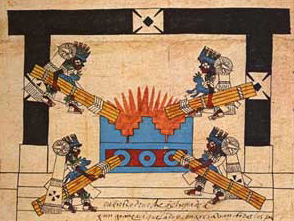| FAMSI © 2001: Susan Milbrath |
||
Research for book on Ancient Mexican Astronomy
Research Year: 2000 A two-semester leave allowed me time to travel extensively to study museum collections, archives, and library holdings related to my research for a book entitled Star Gods of Ancient México: Aztec Astronomy and the Mesoamerican World View. The book focuses on the role of astronomy in Aztec religion and the festival calendar, and how Aztec astronomy relates to the larger Mesoamerican worldview. With a $3,000 travel grant from the Foundation for the Advancement of Mesoamerican Studies, Inc. (FAMSI), I was able to complete an ambitious travel schedule to libraries and museum collections. I had originally intended to concentrate the travel portion of the project over a three-month period from May to July 2000, and write the book during the fall and spring semesters, 2000-2001. I was diverted from this plan from a number of offers to lecture and a month-long trip in January to Yucatán, a wonderful opportunity to do field work with transportation costs paid in exchange for informal lectures to the group of Colgate students. My travel for research funded by FAMSI took me to the following libraries and archives: University of Texas, UC Berkeley, UCLA, Tulane University, University of Pennsylvania, and Museo Nacional de Antropología in México City. In addition, I visited museum collections at the Los Angeles County Museum of Art and the Fowler Museum of Cultural History in Los Angeles, the Hearst Museum of Anthropology at Berkeley, the University of Pennsylvania Museum of Archaeology and Anthropology, the New Orleans Museum of Art, and the Museo del Templo Mayor and the Museo Nacional de Anthropología e Historia in México City. I have just begun to digest the massive amount of research material I compiled this year, and I anticipate the process of writing the book on Aztec Astronomy will begin in the late summer. I have outlined the topics for the book, and have already completed the first chapter, focusing on the astronomical images and ceremonies associated with Tezcatlipoca. His multiple aspects provide a key to understanding the way astrology and astronomy were incorporated in Aztec religion and the festival calendar.
As the Red Tezcatlipoca he is associated with Xipe Totec, a solar god worshipped around the spring equinox. The Black Tezcatlipoca is merged with another solar god, Huitzilopochtli, whose principal ceremony took place at the onset of the dry season. Tezcatlipoca has other aspects linked with the night sky, the moon, the planets, and the stars, especially those in Ursa Major.
The second chapter will focus on the single most important astronomical ritual in the Aztec calendar, the New Fire Ceremony, when the Aztecs looked to the heavens for signs confirming the continuity of the world.
Chapter three will explore solar orientations in architecture and solar images that reflect different seasons or times of day. The fourth chapter will focus on Aztec lunar cults, showing how many different deities embodied the multifaceted nature of the moon. The fifth chapter will detail how the solar and lunar periods were integrated in the Aztec festival calendar. Chapter six will outline the most important Aztec constellations and their role in the seasonal cycle. The final chapter will compare the Postclassic Aztec system with that of the larger Mixteca-Puebla sphere, including Postclassic Maya sites like Santa Rita, Tulúm, and Mayapán, where Mixteca-Puebla style murals have been recovered recently. This chapter will also discuss the role of astronomy in developing the Mesoamerican worldview among the Classic period civilizations, tracing some of these concepts back to the earliest civilizations of México and Guatemala. Click to download the report in PDF format: Research for book on Ancient Mexican Astronomy (194 KB) The PDF files require Adobe Acrobat Reader.
Submitted 06/01/2001 by: |
||
| Return to top of page | ||
|
Text links to all pages at this site are available at the FAMSI INDEX |
||





